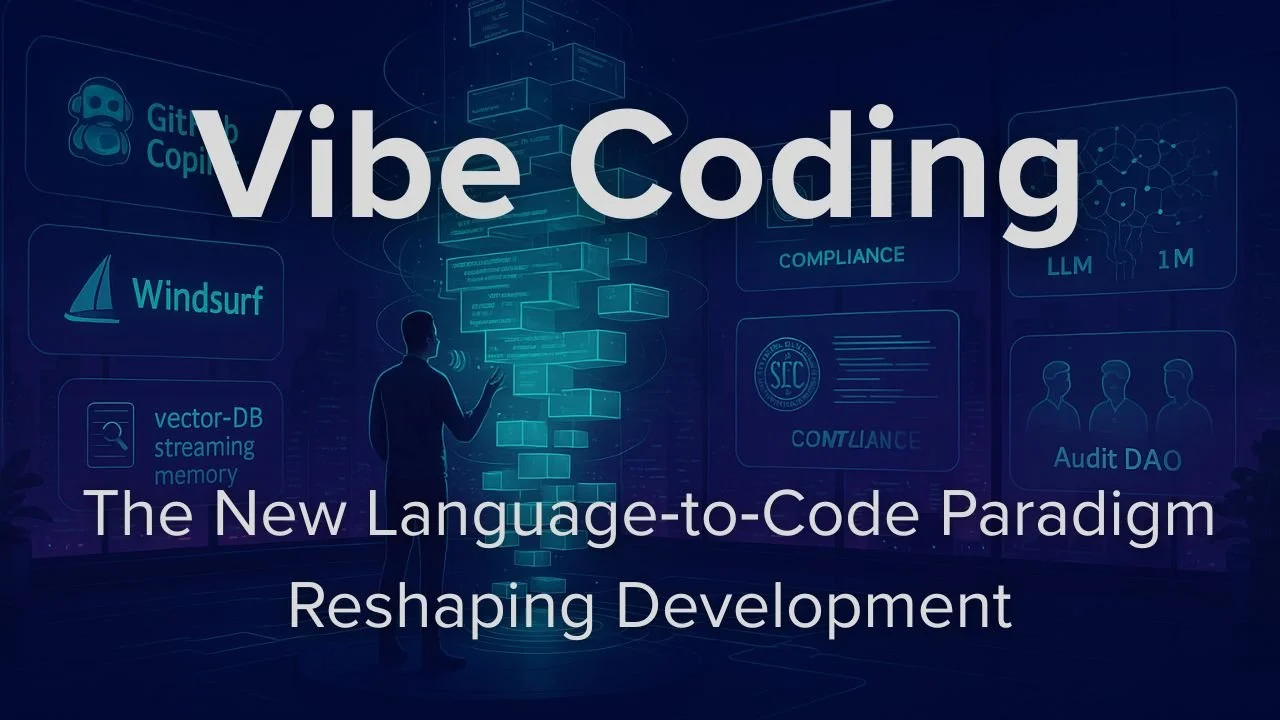Vibe Coding: The New Language‑to‑Code Paradigm Reshaping Development
A quarter of Y Combinator’s Winter 2025 startups ship codebases that are over 90% AI‑generated, and the cohort has been growing at a rate of 10 % week‑over‑week. The statistic captures how conversational code generation, called vibe coding, is compressing idea‑to‑deployment cycles across the innovation stack.
"Vibe coding" refers to a natural‑language‑to‑code workflow where developers articulate desired functionality conversationally, and AI systems generate corresponding implementations. Unlike traditional pair‑programming or code‑completion tools, vibe coding elevates builders to higher abstraction layers while preserving control. Lean teams achieve outputs once requiring full engineering departments, and the innovative approach benefits everyone: software engineers, designers, product managers, and non-technical members, too.
Organizational Implementation
Tool uptake is unmistakable with GitHub Copilot popular with millions of users, and Windsurf, another popular vibe coding tool launched just a few months ago, reportedly in talks for being acquired by OpenAI for $3B.
Enterprises adopting vibe coding gain a significant drop in boilerplate tasks even at a stage where pipeline integration is still incomplete. Leading financial institutions respond with hardened flows, chaining AI code generation to automated validation pipelines that enforce bank‑specific patterns and SEC mandates, trimming standard API delivery from weeks to hours.
Blockchain and Smart‑Contract Applications
Vibe coding’s leverage compounds in decentralized systems. Projects built with structured AI‑assist compared with hand‑coded counterparts can show a marked decrease in vulnerabilities. While centralized custodians lean on off‑chain CI/CD scanners, decentralized ecosystems favor bounty‑driven audit DAOs—an explicit contrast between closed assurance loops and open adversarial review.
Regulatory and Governance Considerations
Regulators are moving in this area as well. The EU’s AI Act and the SEC’s FinHub both draft guidance on AI‑generated critical code. LLM context ceilings, currently between 100K-1M tokens, still hinder multi‑module reasoning; teams mitigate by streaming vector‑DB memory and anchoring releases to on‑chain proofs.
Cultural adoption, as is often the case, drives bottom‑up pressure for enterprise enablement, and the emergence of vibe coding represents more than incremental productivity gains, allowing a profound restructuring of the tech‑talent stack. CIOs revising hiring profiles can prioritize systems thinking over syntax mastery.
This realignment widens the strategic aperture for enterprises that effectively balance accelerated development with resilient governance. As business‑logic expression and code implementation converge, leaders can translate intent into production systems with unprecedented speed and precision. Beyond Enterprizes invites forward‑thinking executives to explore bespoke adoption roadmaps—secure, compliant, and outcome‑driven.
Beyond's Approach to Vibe Coding
At Beyond Enterprizes, we've fully embraced vibe coding as a new component of our development philosophy. We actively encourage our team members and external development resources to adopt these tools without reservation, recognizing their power to dramatically accelerate iteration cycles and compress development timelines. Our approach leverages vibe coding most effectively for rapidly prototyping experiments and ideas, transforming conceptual frameworks into functional implementations at speeds previously unattainable.
We've discovered significant advantages in strategically layering different vibe coding tools, as each excels in specific niches: tools for front‑end implementation, agentic frameworks, even command line tools accelerating the setup of complex environments and managing dependencies efficiently. This orchestrated toolchain approach maximizes both development velocity and technical quality, allowing us to deliver enterprise‑grade solutions while maintaining the agility of a startup.
This deliberate, multi‑layered vibe coding discipline allows Beyond to position both our clients and internal teams at the forefront of a fundamental shift in how software creates business value, where strategic vision translates directly into deployed systems with unprecedented efficiency.

